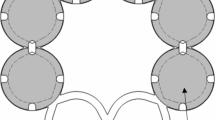Abstract
Traditionally manufactured for ropes and fishing lines, braids are now found in structural composite parts used in the transportation industries and the medical sector. Braiding machines are increasing in size and complexity. However, engineers mostly rely on expertise and on trials and errors to select a collision-free carrier arrangement, which is inefficient in terms of both time and resources. In this paper, we propose a method, based on graph theory, to detect collisions between carriers for any braiding machine configuration and for any number of carriers. To do so, the braiding machine is modeled as a graph. Each horngear is represented by a face and each horngear slot is represented by a vertex. A collision detection algorithm is developed, which validates or invalidates the proposed carrier arrangement. Two case studies are carried out to demonstrate the algorithm. The first one is carried out on a traditional maypole braiding machine, while the second one is done on a T-shape braider. The T-shape braider has a more complex configuration with horngears having different number of slots and diameters. The developed solution is an efficient method to detect collisions based on any carrier arrangement.











Similar content being viewed by others
References
Giurgiutiu V (2016) Structural Health Monitoring of Aerospace Composites. Elsevier. https://doi.org/10.1016/C2012-0-07213-4
Slayton R, Spinardi G (2016) Radical innovation in scaling up: Boeing’s Dreamliner and the challenge of socio-technical transitions. Technovation 47:47–58
Mallick PK (2007) Fiber-reinforced composites: materials, manufacturing, and design. CRC Press. https://doi.org/10.1201/9781420005981
Okano M, Nakai A, Hamada H (2005) Axial crushing performance of braided composite tubes. Int J Crashworthiness 10:287–294
Hamada H (1997) Can braided composites be used for crushing elements in cars. Proc. ICCM-11, 1, 218-46
Ko FK, Pastore CM, Head AA (1989) Atkins & Pearce handbook of industrial braiding. Atkins & Pearce, Covington
Potluri P, Rawal A, Rivaldi M, Porat I (2003) Geometrical modelling and control of a triaxial braiding machine for producing 3D preforms. Compos A: Appl Sci Manuf 34:481–492
Harris B (2003) Fatigue in composites: science and technology of the fatigue response of fibre-reinforced plastics. Woodhead Publishing, Sawston
Bilisik K (2013) Three-dimensional braiding for composites: a review. Text Res J 83:1414–1436
Wang Z, Zhang G, Zhu Y, Zhang L, Shi X, Wang W (2019) Theoretical analysis of braiding strand trajectories and simulation of three-dimensional parametric geometrical models for multilayer interlock three-dimensional tubular braided preforms. Text Res J 89(19-20):1306–4322
Yu Q, Sun Z, Qiu Y, Zhou S, Chen Y, Wu J et al (2017) Study on the braiding of preform with special-shaped sections based on the two-dimensional braiding process. Text Res J 89:172–181
de Oliveira Simões J, Marques AT (2001) Determination of stiffness properties of braided composites for the design of a hip prosthesis. Compos A: Appl Sci Manuf 32: 655–662
Mehboob H, Chang S-H (2014) Application of composites to orthopedic prostheses for effective bone healing: A review. Compos Struct 118:328–341
Huang Z ming (2000) The mechanical properties of composites reinforced with woven and braided fabrics. Compos Sci Technol 60(4):479-498
Tada M, Uozumi T, Nakai A, Hamada H (2001) Structure and machine braiding procedure of coupled square braids with various cross sections. Compos A: Appl Sci Manuf 32:1485–1489
Kyosev Y (2014) Machine configurator for braided composite profiles with arbitrary cross section. In: 16th European conference on composite materials ECCM. Vol. 16, 22-26.06.2014. Seville-Spain
Chengjie D, Zhuo M, Yujing Z, Yize S (2019) Modeling and analysis of the carrier arrangement in square rotary braiding. Text Res J 89:4208–4219
Agnarsson G, Greenlaw R (2006) Graph theory: Modeling, applications, and algorithms. Pearson-Prentice Hall, Hoboken
Farrahi AH, Goldberg AT, Bagasol L, Jung J (2017) Applying graph theory to problems in air traffic management. In: 17th AIAA Aviation Technology, Integration, and Operations Conference, p 3775. https://doi.org/10.2514/6.2017-3775
Likaj R, Shala A, Mehmetaj M, Hyseni P, Bajrami X (2013) Application of graph theory to find optimal paths for the transportation problem. IFAC Proc Vol 46:235–240
Farid G, Cocuzza S, Younas T, Razzaqi AA, Wattoo WA, Cannella F et al (2022) Modified A-Star (A*) Approach to Plan the Motion of a Quadrotor UAV in Three-Dimensional Obstacle-Cluttered Environment. Appl Sci 12:5791
Ding Z, Li J, Yang M, Yan Z, Li B, Chen W (2020) A Multi-channel Anti-collision Algorithm in Multi-reader RFID Networks. In: International Conference on Smart Grid and Internet of Things, pp 220–238. https://doi.org/10.1007/978-3-030-69514-9_18
Bondy JA, Murty USR (1976) Graph theory with applications vol. 290. Macmillan, London
Funding
This work was supported by The Natural Sciences and Engineering Research Council of Canada [NSERC, RDCPJ 543847–19]; PRIMA Quebec [R18-13–003]; FilSpec Inc; Pultrusion Techniques; and Bauer Hockey ltd.
Author information
Authors and Affiliations
Corresponding author
Ethics declarations
Competing interests
The authors have no relevant financial or non-financial interests to disclose.
Additional information
Publisher's note
Springer Nature remains neutral with regard to jurisdictional claims in published maps and institutional affiliations.
Rights and permissions
Springer Nature or its licensor (e.g. a society or other partner) holds exclusive rights to this article under a publishing agreement with the author(s) or other rightsholder(s); author self-archiving of the accepted manuscript version of this article is solely governed by the terms of such publishing agreement and applicable law.
About this article
Cite this article
Assi, P., Achiche, S. & Laberge Lebel, L. Application of graph theory for detecting carriers’ collisions in braiding machines. Int J Adv Manuf Technol 126, 2337–2348 (2023). https://doi.org/10.1007/s00170-023-11245-z
Received:
Accepted:
Published:
Issue Date:
DOI: https://doi.org/10.1007/s00170-023-11245-z




